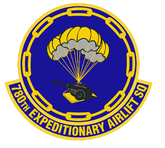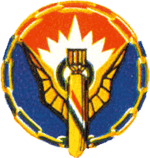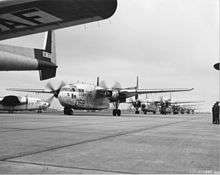780th Expeditionary Airlift Squadron
| 780th Expeditionary Airlift Squadron | |
|---|---|
|
A C-17 Globemaster III of the 780th taking off from Mihail Kogalniceanu Air Base | |
| Active | 1943–1945; 1953-1958; 2014-present |
| Role | Airlift |
| Decorations |
Distinguished Unit Citation Air Force Outstanding Unit Award |
| Insignia | |
| 780th Expeditionary Airlift Squadron emblem |
 |
| 780th Troop Carrier Squadron emblem (Approved 17 June 1955)[1] |
 |
| 780th Bombardment Squadron emblem |
 [2] [2] |
The 780th Expeditionary Airlift Squadron is an active United States Air Force unit. Its previous assignment was to the 317th Troop Carrier Wing, stationed at Évreux-Fauville Air Base, France.
It was inactivated on 8 March 1958, but was reactivated in 2013 as an expeditionary squadron.
History

Activated as a Consolidated B-24 Liberator heavy bomber squadron in mid-1943, it trained under the Second Air Force. It deployed to the Mediterranean Theater of Operations (MTO) in March 1944, where it was assigned to the Fifteenth Air Force. It flew strategic bombardment combat missions over France, Germany, Italy, Austria and the Balkans until the German capitulation in May 1945.
The squadron was attached to Air Transport Command in June 1945. It used its B-24s as transports, flying personnel from Trinidad to Florida. The unit was inactivated in place in Trinidad during July 1945. Redesignated as a B-29 Superfortress very heavy bomber squadron in the reserves later in 1945, it was not, however, activated due to budget restrictions.

The unit was reactivated in 1953 as a Tactical Air Command Fairchild C-119 Flying Boxcar Troop Carrier squadron under the Eighteenth Air Force. It primarily flew cargo transport missions, but also supported US Army airborne parachute units on maneuvers from Fort Bragg, North Carolina and Fort Campbell, Kentucky.
The squadron was reassigned in 1953 as a troop carrier squadron, in France. It performed theater airlift and transport operations until 1958 when it was again inactivated due to budget restrictions.
The 780th was reactivated in 2013 to facilitate the U.S. and NATO withdrawal in Afghanistan.
Lineage
- Constituted as the 780th Bombardment Squadron (Heavy) on 19 May 1943
- Activated on 1 August 1943
- Redesignated 780th Bombardment Squadron, Heavy c. 20 August 1943
- Inactivated on 31 July 1945
- Redesignated 780th Bombardment Squadron, Very Heavy on 14 November 1945
- Redesignated 780th Troop Carrier Squadron, Medium on 22 December 1952
- Activated on 1 February 1953
- Inactivated on 8 March 1958
- Redesignated 780th Expeditionary Airlift Squadron on 18 June 2002
- Activated c. February 2014
Assignments
- 465th Bombardment Group, 1 August 1943 – 31 July 1945
- 465th Troop Carrier Group, 1 February 1953
- 465th Troop Carrier Wing, 12 March 1957
- 317th Troop Carrier Wing, 8 July 1957 – 8 March 1958
Stations
- Alamogordo Army Air Field, New Mexico, 1 August 1943
- Kearns Center, Utah, c. 13 September 1943
- McCook Army Air Field, Nebraska, c. 5 October 1943 – 1 February 1944
- Pantanella Airfield, Italy, 15 March 1944 – June 1945
- Waller Field, Trinidad, c. 15 June – 31 July 1945
- Donaldson Air Force Base, South Carolina, 1 February 1953 – December 1953
- Toul-Rosières Air Base, France, 26 December 1953
- Évreux-Fauville Air Base, France, 6 December 1954 – 8 March 1958
- Mihail Kogalniceanu Air Base, Romania, February 2014 – present
Aircraft
- Consolidated B-24 Liberator, 1943–1945
- Fairchild C-119 Flying Boxcar, 1953–1957
- Lockheed C-130A Hercules, 1957–1958
- McDonnell Douglas C-17A Globemaster III, 2014–present
References
Notes
Bibliography
![]() This article incorporates public domain material from the Air Force Historical Research Agency website http://www.afhra.af.mil/.
This article incorporates public domain material from the Air Force Historical Research Agency website http://www.afhra.af.mil/.
- Maurer, Maurer, ed. (1982) [1969]. Combat Squadrons of the Air Force, World War II (PDF) (reprint ed.). Washington, DC: Office of Air Force History. ISBN 0-405-12194-6. LCCN 70605402. OCLC 72556.
- Watkins, Robert A. (2013). Insignia and Aircraft Markings of the U.S. Army Air Force In World War II. Volume V, Pacific Theater of Operations. Atglen,PA: Shiffer Publishing, Ltd. ISBN 978-0-7643-4346-9.
